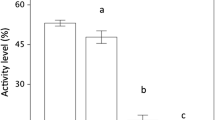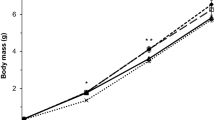Abstract
Many organisms show predator-induced behavioural and morphological phenotypic plasticity. These defence mechanisms are often expressed simultaneously. To estimate the relative importance of these two defences, we conducted a laboratory experiment using tadpoles of the common frog (Rana temporaria) as prey and Aeshna dragonfly larvae as predators. We first raised tadpoles in the presence and absence of caged predators to induce differences in defensive morphology, and then conducted free ranging predator trials in environments that were either with or without the presence of predation cues to induce differences in defensive behaviour. This 2 × 2 design allowed us to separate the effects of inducible morphology from inducible behaviour. Caged predators induced deeper bodies and tailfins and reduced activity levels in tadpoles. The time to first capture was shortest in tadpoles without morphological or behavioural defences. Tadpoles with a behavioural defence had a significantly longer time to first capture. Tadpoles with only antipredator morphology tended to have a longer time to first capture as compared to those without any induced defences. This treatment also had a higher number of injured tadpoles as compared to other treatments, suggesting that inducible morphology facilitates predator escape due to the ‘lure effect’. However, tadpoles with both behavioural and morphological defences did not have a longer time to first capture as compared to tadpoles with only morphological or behavioural induced defences. Our results suggest that both behavioural and morphological antipredator responses contribute to reduced capture efficiency by predators, but their simultaneous expression did not have any additive effect to the time of first capture and survival, and that the morphology response is most effective when tadpoles are active.



Similar content being viewed by others
References
Abràmoff MD, Magalhães PJ, Ram SJ (2004) Image processing with ImageJ. Biophotonics Intern 11:36–42
Abrams PA (1983) Foraging time optimization and interactions in food webs. Am Nat 124:80–96
Alvarez D, Nicieza AG (2006) Factors determining tadpole vulnerability to predators: can prior experience compensate for a suboptimal shape? Evol Ecol 20:523–534
Alvarez D, Nicieza AG (2009) Differential success of prey escaping predators: tadpole vulnerability or predator selection? Copeia 2009:453–457
Altwegg R (2003) Hungry predators render predator-avoidance behavior in tadpoles ineffective. Oikos 100:311–316
APHA (1985) Standard methods for the examination of water and wastewater, 16th edn. American Public Health Association, Washington
Blair J, Wassersug RJ (2000) Variation in the pattern of predator-induced damage to tadpole tails. Copeia 2000:390–401
Bourdeau PE (2010) An inducible morphological defence is a passive by-product of behaviour in a marine snail. Proc R Soc Lond B 277:455–462
Bourdeau PE, Johansson F (2012) Predator-induced morphological defences as by-products of prey behaviour: a review and prospectus. Oikos 121:1175–1190
Calsbeek R, Kuchta S (2011) Predator mediated selection and the impact of developmental stage on viability in wood frog tadpoles (Rana sylvatica). BMC Evol Biol 11:353
Dayton GH, Saenz D, Baum KA, Langerhans BR, DeWitt TJ (2005) Body shape, burst speed and escape behavior of larval anurans. Oikos 111:582–591
DeWitt TJ, Sih A, Hucko J (1999) Trait compensation and cospecialization in a freshwater snail: size, shape and antipredator behaviour. Anim Behav 58:397–407
Doherty PA, Wassersug RJ, Lee JM (1998) Mechanical properties of the tadpole tail fin. J Exp Biol 201:2691–2699
Ferrari MCO, Wisenden BD, Chivers DP (2010) Chemical ecology of predator-prey interactions in aquatic ecosystems: a review and prospectus. Can J Zool 88:698–724
Gosner KL (1960) A simplified table for staging anuran embryos larvae with notes on identification. Herpetologica 16:183–190
Hettyey A, Rölli F, Thürlimann N, Zürcher A-C, Van Buskirk J (2012) Visual cues contribute to predator detection in anuran larvae. Biol J Linn Soc 106:820–827
Hoff KVS, Wassersug RJ (2000) Tadpole locomotion: axial movement and tail functions in a largely vertebraeless verterbrate. Am Zool Res 40:62–76
Hülsmann S, Wagner A (2007) Multiple defence strategies of Daphnia galeata against predation in a weakly stratified reservoir. Hydrobiologia 594:187–189
Johansson F (1991) Foraging modes in an assemblage of odonate larvae—effects of prey and interference. Hydrobiologia 209:79–87
Johansson F (1993) Diel feeding behaviour in larvae of four odonate species. J Insect Behav 6:253–264
Johansson F, Andersson J (2009) Scared fish get lazy, and lazy fish get fat. J Anim Ecol 78:772–777
Johnson JB, Burt DB, DeWitt TJ (2008) Form, function, and fitness: pathways to survival. Evolution 62:1243–1251
Kraft PG, Franklin CE, Blows MW (2006) Predator-induced phenotypic plasticity in tadpoles: extension or innovation? J Evol Biol 19:450–458
Laurila A, Kujasalo J, Ranta E (1998) Predator-induced changes in life history in two anuran tadpoles: effects of predator diet. Oikos 83:307–317
Laurila A, Lindgren B, Laugen AT (2008) Antipredator defenses along a latitudinal gradient in Rana temporaria. Ecology 89:1399–1413
Lima SL, Dill LM (1990) Behavioural decisions made under the risk of predation: a review and prospectus. Can J Zool 68:619–640
McCollum SA, Van Buskirk J (1996) Costs and benefits of a predator-induced polyphenism in the gray treefrog Hyla chrysoscelis. Evolution 50:583–593
McIntyre PB, Baldwin S, Flecker AS (2004) Effects of behavioral and morphological plasticity on risk of predation in a neotropical tadpole. Oecologia 141:130–138
Mikolajewski DJ, Johansson F (2004) Morphological and behavioral defenses in dragonfly larvae: trait compensation and co-specialization. Behav Ecol 15:614–620
Nilsson PA, Brönmark C, Pettersson LB (1995) Benefits of a predator-induced morphology in crucian carp. Oecologia 104:291–296
Nunes AL, Cruz MJ, Tejedo M, Laurila A, Rebelo R (2010) Nonlethal injury caused by an invasive alien predator and its consequences for an anuran tadpole. Basic Appl Ecol 11:645–654
Nunes AL, Orizaola G, Laurila A, Rebelo R (2014) Morphological and life-history responses of anurans to predation by an invasive crayfish: an integrative approach. Ecol Evol 4:1491–1503
Nunes AL, Richter-Boix A, Laurila A, Rebelo R (2013) Do anuran larvae respond behaviourally to chemical cues from an invasive crayfish predator? A community-wide study. Oecologia 171:115–127
Orizaola G, Dahl E, Laurila A (2012) Reversibility of predator-induced plasticity and its effect at a life-history switch point. Oikos 121:44–52
Relyea RA (2004) Fine-tuned phenotypes: tadpole plasticity under 16 combinations of predators and competitors. Ecology 85:172–179
Rohlf FJ (2004) TpsSplin. Department of Ecology and Evolution, State University of New York, Stony Brook
Rohlf FJ (2007) TpsRelw. Department of Ecology and Evolution, State University of New York, Stony Brook
Rohlf FJ (2008) TpsDig2. Department of Ecology and Evolution, State University of New York, Stony Brook
Rohlf FJ, Marcus LF (1993) A revolution in morphometrics. Trends Ecol Evol 8:129–132
Rundle SD, Brönmark C (2001) Inter- and intraspecific trait compensation of defence mechanisms in freshwater snails. Proc R Soc Lond B 268:1463–1468
Schoeppner NM, Relyea RA (2005) Damage, digestion, and defence: the roles of alarm cues and kairomones for inducing prey defences. Ecol Lett 8:505–512
Schoeppner NM, Relyea RA (2009) Interpreting the smells of predation: how alarm cues and kairomones induce different prey defences. Funct Ecol 23:1114–1121
Sih A (1987) Predators and prey lifestyles: an evolutionary and ecological overview. In: Sih A, Kerfoot WC (eds) Predation: Direct and indirect impacts on aquatic communities. University Press of New England, Hannover, pp 203–224
Smith DC, Van Buskirk J (1995) Phenotypic design, plasticity, and ecological performance in two tadpole species. Am Nat 145:211–233
Stauffer H-P, Semlitsch RD (1993) Effects of visual, chemical and tactile cues of fish on the behavioural responses of tadpoles. Anim Behav 46:355–364
Steiner UK (2007) Investment in defense and cost of predator-induced defense along a resource gradient. Oecologia 152:201–210
Teplitsky C, Plenet S, Léna JP, Mermet N, Malet E, Joly P (2005) Escape behaviour and ultimate causes of specific induced defences in an anuran tadpole. J Evol Biol 18:180–190
Tollrian R, Harvell CD (1999) The ecology and evolution of inducible defences. Princeton University Press, Princeton
Van Buskirk J (2002) Phenotypic lability and the evolution of predator-induced plasticity in tadpoles. Evolution 56:361–370
Van Buskirk J, Anderwald P, Lüpold S, Reinhardt L, Schuler H (2003) The lure effect, tadpole tail shape, and the target of dragonfly strikes. J Herpetol 37:192–196
Van Buskirk J, Krügel A, Kunz J, Miss F, Stamm A (2014) The rate of degradation of chemical cues indicating predation risk: an experiment and review. Ethology 120:942–949
Van Buskirk J, McCollum SA (2000) Functional mechanisms of an inducible defence in tadpoles: morphology and behaviour influence mortality risk from predation. J Evol Biol 13:336–347
Van Buskirk J, McCollum SA, Werner EE (1997) Natural selection for environmentally induced phenotypes in tadpoles. Evolution 51:1983–1992
Van Buskirk J, Relyea RA (1998) Selection for phenotypic plasticity in Rana sylvatica tadpoles. Biol J Linn Soc 65:301–328
Werner EE, Anholt BR (1993) Ecological consequences of the trade-off between growth and mortality rates mediated by foraging activity. Am Nat 142:242–272
Wilbur HM, Semlitsch RD (1990) Ecological consequences of tail injury in Rana tadpoles. Copeia 1990:18–24
Wisenden BD (2000) Olfactory assessment of predation risk in the aquatic environment. Philos T Roy Soc B 355:1205–1208
Wishingrad V, Ferrari MCO, Chivers DP (2014) Behavioural and morphological defences in a fish with a complex antipredator phenotype. Anim Behav 95:137–143
Acknowledgments
This research was made in collaboration between the HAS University of Applied Sciences of Den Bosch, the Netherlands and the Department of Ecology and Genetics at the Uppsala University, Sweden. The article is a revised version of an internship report published at the HAS University of Applied Sciences of Den Bosch, the Netherlands. Osama Almalik provided statistical advice. We thank Pablo Burraco Gaitán for his valuable advice for constructive comments on the manuscript. This research is supported by the Swedish Research Council (to AL).
Author information
Authors and Affiliations
Corresponding author
Ethics declarations
Ethical standards
Applicable international, national and/or institutional guidelines for the care and use of animals were followed. All procedures performed involving animals were in accordance with the ethical standards of the department and were approved by the Swedish Board of Agriculture (C21/14).
Additional information
Communicated by M. Gibbons
Electronic supplementary material
Below is the link to the electronic supplementary material.
ESM 1
(DOCX 208 kb)
Rights and permissions
About this article
Cite this article
Dijk, B., Laurila, A., Orizaola, G. et al. Is one defence enough? Disentangling the relative importance of morphological and behavioural predator-induced defences. Behav Ecol Sociobiol 70, 237–246 (2016). https://doi.org/10.1007/s00265-015-2040-8
Received:
Revised:
Accepted:
Published:
Issue Date:
DOI: https://doi.org/10.1007/s00265-015-2040-8




